GSX-R
2006 GSX-R 600, 2006 GSX-R 750
Phillip Island, Australia
February 23, 2006
“Craig says you need to pull your finger out of it” Melissa offered helpfully as I was removing my helmet and gloves. Craig, as it happens, is a Bridgestone tire representative and racer in the Australian National Superbike series who was at Phillip Island to assist Suzuki with tire support for the launch of the GSX-R 600 and 750 and to, apparently, record and opine about the lap times of your correspondent to your correspondent’s beautiful and talented associate. “I told him it was the first session, it was damp, and that you would go faster once you felt out the track and tires” Melissa continued. “What if I don’t?” “You will, or we can’t go to the pub with them later”
For people that actually purchase their own middleweight race bikes there are currently two choices, the Yamaha R-6 or the Suzuki GSX-R 600. The two have been trading the title of best race platform for the last six years. Suzuki had it easy for a while in the last 90s when they could sleeve down their literal class killing 750 and have the most competitive 600 on the track; now both Yamaha and Suzuki are pulling out every trick in the book trying to reap the reward of selling tens of thousands of units and the bragging rights between the two rivals. The stakes are high and the customers are fickle. Suzuki saw its sales of GSX-R 600 slashed in 2005 when Yamaha released the much improved 2005 R-6 compared to the 2004 Suzuki offering which was basically a warmed over version of the 2001 bike. Now Suzuki is releasing the bike that they really needed last year as this season it is being stacked up against the high strung track focused R-6.
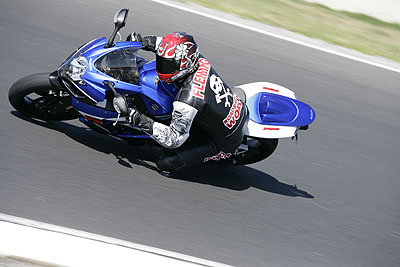
At some point people will look back and wonder what purpose
the duck billed tail section served 21st century man.
The 2006 is the first genuinely all new GSX-R 600 since 2001 with a new engine layout, new injectors, new chassis, bodywork, throttle bodies et al. The new bike is dramatically smaller (dare I say R-6 like?) than its predecessors. It is lower, shorter, slimmer and although not lighter, it feels like it is. The compact nature of the bike invites the rider to become closer to the bike. The weight of the bike is concentrated in the center of the bike and is very low in the chassis. Suzuki kept more than a vestigial windshield and the bubble is actually quite ample, as long as the rider is in a full race tuck.
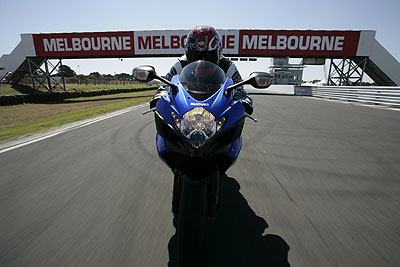
A surprisingly effective bubble.
Although the 2006 is only up on the 2005 model 5bhp (from 120 to 125) they accomplished this with the arduous task of reengineering a large number of aspects of the engine which allowed for the higher peak output without sacrificing the mid-range. It is relatively easy to boost peak bhp by rotating the torque curve and sacrificing mid-range but that does not usually result in a motorcycle that is faster around a racetrack. This engine revs out faster and pulls noticeably harder than the 2005 model. Also, with the dual injector set up on the 2006 it will be easier for tuners to extract even more power from the engine without running into fuel flow limitations on the injectors.
“Quantify that for me.” “He got you at a 1:53 flat. You need to get to 50 to hold your head up. Sub 50 and you get mad respect. I checked the schedule, you have two twenty minute sessions to win us an invitation to the pub tonight. Drop four seconds honey.”
Faced with that challenge I realized that my planned day of lazily enjoying a day of casual riding at the stunning Phillip Island circuit (one of the three best circuits in the world) had been replaced with a focused mission to impress some faceless tire representative and my impish companion. Phillip Island is mainly long flowing turns that reward high corner speed. I decided that the low hanging fruit was to be plucked by laying off the brakes into the intimidating fast turn one and by using the brakes much harder into the two hairpins. The track does not have many visual cues to use for brake markers or turn in points. This leads to the dreaded “oh-fuck-I-am-going-to-run-out-of-track” moment when one realizes that the higher entry speed coupled with an early turn in point is resulting in the rapid evaporation of usable exit pavement. Since such sphincter puckering experiences are unpleasant at best, and painful at worst, it can be difficult to suck it up and trust that some unknown bike is going to be able to tighten an arc at will to keep the front tire on tarmac and not gravel.
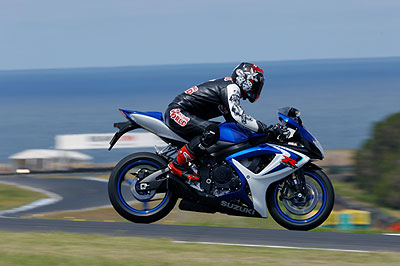
Stopping hard but not to savor the view.
This one does. The bike is physically so much smaller than the 2005 that I needed to actually adjust my mental image of lean angle because my knee was hitting the pavement so early. The chassis of the bike actually rolls so easily from side to side that not only can you gather it up and tighten a long flowing line but the bike almost falls over when squaring off a low speed turn.
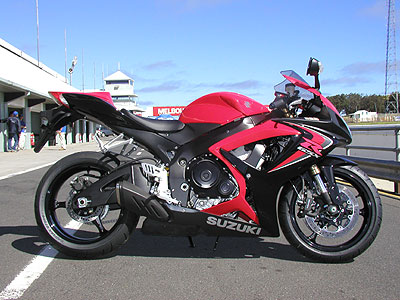
Sculpted.
Attempting to charge the two tight turns on the track revealed that the brakes suffer from some of the same problems of the 2005. Although the components should be top shelf the brakes lack initial bite and, when used aggressively, start getting a bit mushy. The all new slipper clutch is a welcome addition so that at least when inexorably drifting past the intended turn in point hard on the fading brakes one does not have to suffer the indignity of a hopping rear wheel.
“You dropped two seconds down to 1:51 flat. They are warming up to you but you are going to need to drop at least another second in the last session.”
Phillip Island is very smooth by American track standards. The GSX-Rs have always had high quality forks but with an incredible small range of usable fork damping settings where even an eighth of a turn makes the difference between right and wrong. I had been riding the bike as delivered with 1.75 turns out from full hard rebound and the fork appeared to have virtually no rebound damping. Winding in the adjusters a full turn was not discernable in the pits so I decided to trust my experience and set it to my feel instead of listening to my well meaning but concerned tuner. I decided to have 1/8th out from full rebound and one full turn out for compression. The shock was already about right and I was not experiencing any rear wheel traction issues, I was looking for feel and confidence in the front tire to get Melissa her pub invite.
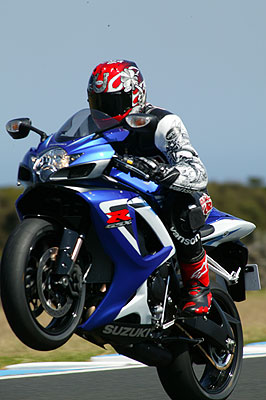
There are two ways to distinguish the 750 from
the 600. One is the color of the forks, the
other is the propensity to wheelie.
I knew the next second was going to come from sucking it up in two places. Neither of them were going to be fun. One is an off camber decreasing radius third gear turn, the second one is the series of left turns leading onto the front straight. Both places require precise use of available grip to prevent equipment (bikes, leathers, helmets) scuffing. The second requires judicious usage of front and rear wheel traction because one has to accelerate from second through forth gears all while turning left and hitting some very precise lines.
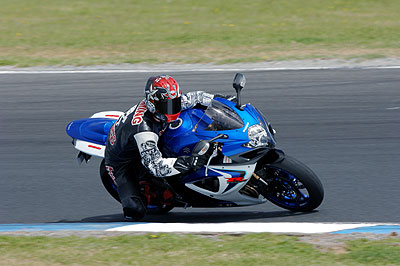
These leathers were incredibly popular with the Australians.
The GSX-R, like a good race bike, responded to the suspension tuning. Since my mechanic had already reversed the shifting I could catch gears while leaned over in the long left feeding onto the front straight. The stiffer front setting transmitted more of the front tire feel and gave the confidence to enter the fast turns fast and hard while the nimble handling reassured me that if I got it wrong I would be able to correct the line.

With the adjustable footpegs is an adjustable position for the shift lever
which also allows for quick and easy reversal of shift pattern. This sort of
detail has always displayed Suzuki’s track focus.
The first part of the session I had to catch and pass a few other bikes to get clear track for the lap time attempt. The gearing on the bike was too tall for Phillip Island but the mid-range power allowed the engine to pull itself out of most of the turns.
With the engine running through its power band, snicking reverse shifts, tuning the suspension, passing other riders on the brakes, it was easy to forget that this bike was still in street trim with street tires and the big smile on Melissa’s face would have been right at home in the winner’s circle at the GNF. Yamaha might have released the sharper bike but Suzuki might have hit the better balance of usable performance.
“1:49 flat, mad respect, we’re going to the pub”
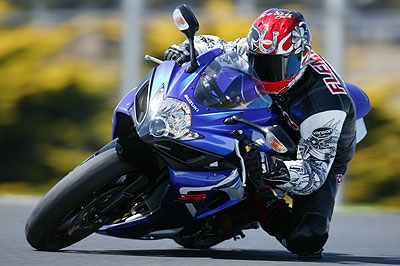
Street tires.
The 2006 is all new. Long time consumers of GSX-Rs may recognize some of the roots of some of the components but there is virtually nothing of the older bikes in this one. From the cast frame to the fuel and exhaust systems to the new engine layout and design this is an all new bike.

Nestled into the bodywork is the exhaust system valve.
Although the engine retains the stroke and bore of previous engines the entire motor is 20mm shorter and the length of the motor is reduced by 54mm to make room for a longer swingarm. The crank and transmission shafts utilize a new layout that is more compact and requires new crankcase splits. The engine is 16mm narrower by reducing the center to center distance of the cylinders. To further narrow all the ancillary systems the 2006 intake ports are repositioned to allow for narrower, although slightly larger (40mm from 38mm) throttle bodies. The narrower head and throttle bodies allows for a smaller air box (fed by a more efficient ram air system), frame (a whopping 35mm narrower) and gas tank which all contribute to the smaller overall feel of the new bike.

The swingarm is a work of art. The engine has been reworked with the
usual mix of decreased friction, increased combustion efficiency and higher
RPM to boost power. The less sexy improvements are bigger ventilator holes
(39mm versus 35mm) in the crankcases below the cylinder liners to allow
for less pumping losses. A reed valve has been installed in the main
crankcase breather to prevent a partially pressurized air box from impeding
crankcase venting.
Slightly more sexy are the titanium valves (unchanged from 2005 so be prepared to buy a lot of them if you race a lot) with buckets that are 1mm larger both intake and exhaust (26 and 24mm respectively). The exhaust cam has picked up a fair amount of lift from 7.3mm to 8.0mm. The changes to the buckets, cam lift and RPM must have increased the specification and design of the valve springs but if they did Suzuki isn’t talking about it. The radiator is much bigger to increase cooling capacity by 17%.
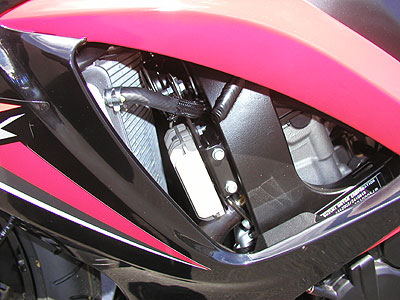
The 2001-2003 GSX-R had a cam position sensor that would overheat when
racing in hot climates and cause all sort of hilarious DNFs. This is a heat sink
for a voltage regulator that is mounted behind a radiator and above an
exhaust pipe. Think it will get hot?
Some bold tuners of 2005 GSX-Rs found that shortening the throttle bodies and replacing the injectors with ones of larger flow resulted in higher horsepower output. The 2006 makes use of both of these tricks. The throttle bodies are 16mm shorter (better for high RPM power) and the throttle bodies pick up an extra four injectors so there are now two per cylinder. The primary injector is used all the time and the secondary that is only used under high fuel demand conditions.
Fed from that higher lift cam the exhaust pipe is a radical departure both by style and design for sporting motorcycles. Although Suzuki never says “We ripped the look off our GP bike” (perhaps because they are not so proud of their GP bike right now) the exhaust pipe does bear a striking resemblance to their ill fated GP bike. A first for the 600 is the SETI exhaust valve that, officially, is there to increase low RPM power and, unofficially, is there to help the bike get through noise tests with a low restriction exhaust system. The exhaust system centralizes and lowers the weight in the bike but it also takes up a lot of the room where the shock linkage would usually reside.
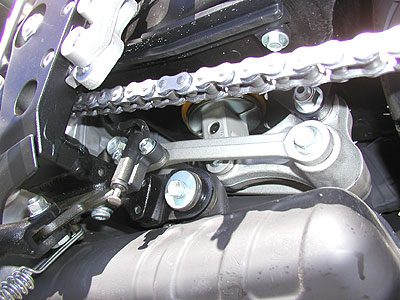
Very flat shock linkage to clear the central exhaust pipe.
The power makes its way through an elegant slipper clutch to revised transmission ratios.
The 97-03 600s had 320mm front rotors, those shrank to 300mm in 2004, they have been bumped up to 310mm for 2006. Larger rotors typically provide better braking and better durability but are heavier. The front wheel has been redesigned to be a bit lighter to offset the increased rotor size. Otherwise the brake system retains the radial mount Tokico calipers and the radial mount master cylinder.
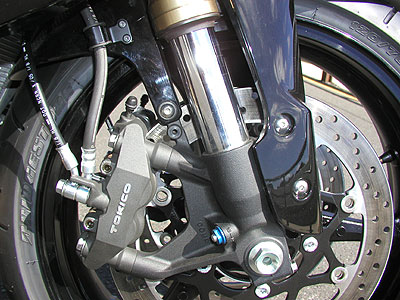
The only thing that would make this better is 320mm rotors.
The black painted frame is now all cast with a repositioned head angle to increase trail to 97mm (from 93mm) and the rake is increased from 23.3 to 23.8. Both of these geometry changes should result in a more stable and planted bike in high speed high lean angle turns but slow handling. This bike turned fast and almost effortlessly so the more conservative geometry was only helping the handling.
Bolted to the frame is a really tasty GP styled swingarm that is 35mm longer than the 2005. The subframe is two casting bolted together. On the front side is an inverted Showa fork that has had the inner tube shrunk from 43mm to 41mm but the thickness of the tubes has been increased to maintain rigidity. The smaller diameter tubes are supposed to reduce stiction in the suspension. The rear shock internals have been shrunk down as well with a smaller piston (40mm from 46mm) and damping rod. The new rear shock is also sporting dual compression adjustments (one for high speed and one for low speed) and is a bit shorter (15mm) than the old shock as well. Since an exhaust system takes up most of the room where a shock linkage would ordinarily be found the linkage has been made very flat.
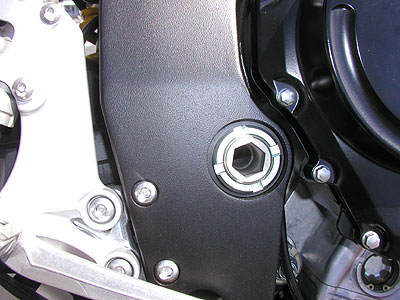
Long swingarms are good for traction. Moving the pivot point forward
allows for a longer swingarm without a longer wheelbase. This one is just
about as far forward as you can get.
Overall the bike has picked up 500 rpm, five bhp and maintained the same weight of 355 lbs.
The GSX-R 750
Let me make this really simple. The 750 costs $1,200 more than the 600, weighs four pounds more and has 20% more horsepower. If you are not racing in the 600 class and are looking at a middleweight bike there is absolutely no reason not to buy the 750 instead.

All the handling, 20% more power with the 750.
There is basically nothing you can do to a 600 to get it up to 150bhp and certainly you are not going to get it for $1,200. There used to be a handling penalty for getting the 750 but it seems that the new 600’s crank is slightly heavier than the old one and this 750 crank seems a bit lighter because there is barely any handling difference between the two.
The 750, however, is a much faster animal. It is not stupid crazy out of control faster. It is just faster. It accelerates in a fuller manner. It spins the rear wheel a bit, it lofts the front more willingly but it corners just as well as the 600. The brakes seem worse on the 750 but that is only because one is carrying another ten mph up to the brake markers.
The 750 engine does feel slightly more buzzy than the 600. Not a lot, just enough to notice when rolling out of the pits in the seat and the pegs.
One thing about the 750 is that it needs absolutely no acclimation. The GSX-R 750 defined sportbikes in 1986 and again in 1996 so it is no surprise that it is still the quintessential sportbike in 2006. It does everything exactly how one would expect. It shifts, accelerates, brakes and turns in such a predictable manner that it is really difficult to not forget completely about the bike and instead put all the attention on the track.
Of course, as a rider, having a bike that does everything so well that you forget about the bike and just concentrate on the riding is exactly what you want.
Technically, the new 750 shares much with the 600. It uses virtually the exact same chassis with the only real difference being the black forks instead of the wheat forks of the 600. It also has “750” stickers on the tail section instead of “600”.
It used to be that all Suzuki sportbikes were heavily based on the core of the 750. Now the 750 seems to be developmentally tacked onto the 600 to the extent that it is still an excellent bike but the power output has not been climbing as one might expect each year. Almost like Suzuki is careful not to cannibalize sales of its premium priced 1,000.
Based on the new case design of the 600 the new 750 motor has a new bore and stroke. The new bike is 70mm X 48.7 versus 72mm and 46mm of the 2005. The width of the engine has been reduced and it looks like Suzuki was running out of room between the liners for the big bore short stroke configuration. Externally the new engine is 34mm shorter, 16mm narrower and 57mm shorter front to rear.
With sportbikes currently taking all their styling cues from MotoGP it will be interesting if other manufacturers begin releasing 800cc bikes in the next couple years, if that happens Suzuki will be sitting pretty since they have been selling them all along.
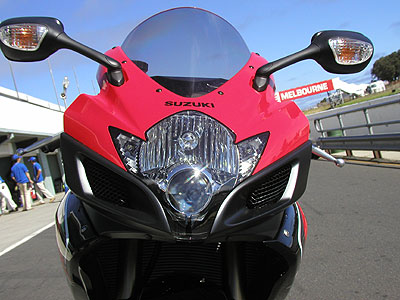
Stacked headlights are not as sexy as the side projectors BUT these
headlights actually allow for fast riding at night on curvy roads or tracks
while the side mounted projectors only point at the ground. Ask me how
I know.
